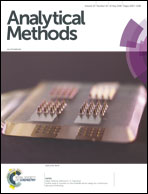Highly selective preconcentration of ultra-trace amounts of lead ions in real water and food samples by dispersive solid phase extraction using modified magnetic graphene oxide as a novel sorbent
Abstract
A simple and rapid dispersive solid-phase extraction method coupled with furnace atomic absorption spectrometry detection was developed for selective separation and preconcentration of ultra-trace amounts of lead ions using modified magnetic graphene oxide such as the pseudo imprinted polymer sorbent in real water and food samples. Some effective parameters in the extraction of lead were selected and optimized. The optimum experimental conditions of the proposed method were: pH, 5.0; amount of absorbent, 1 mg; eluent type and its volume, 50 μL of 0.4 mol L−1 hydrochloric acid; sample solution volume, 30.0 mL. Under the optimum conditions, a high preconcentration factor of 600 was obtained for 30.0 mL of sample solution. The relative standard deviation for seven 20 ng L−1 replicates of lead was 2.4% and the detection limit was 0.18 ng L−1. The proposed method was applied for the determination of lead ions in real water and food samples, and its accuracy was assessed through the analysis of a certified reference water (ERA 1340) and recovery experiments.

- This article is part of the themed collection: Analytical Methods Recent HOT articles


 Please wait while we load your content...
Please wait while we load your content...